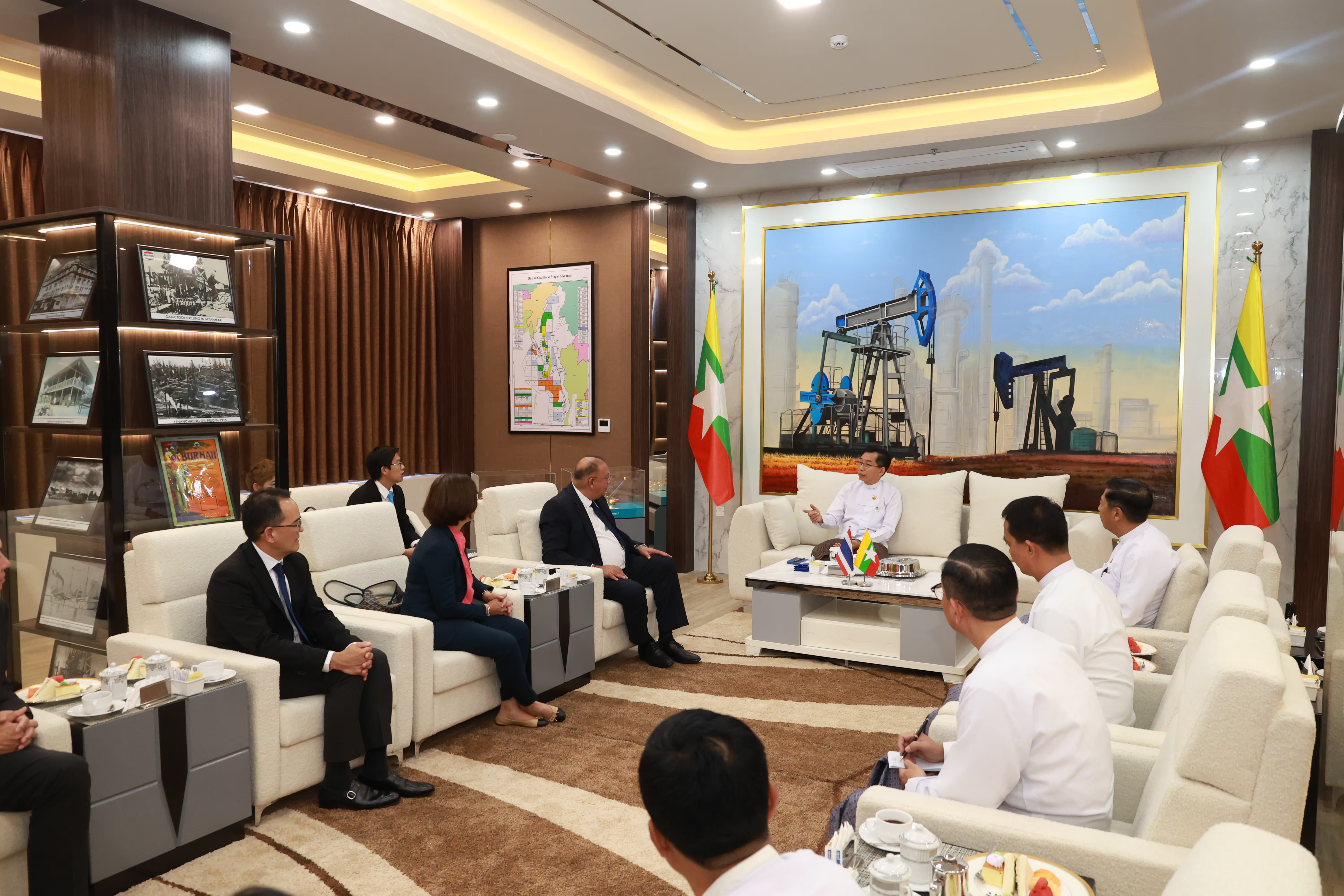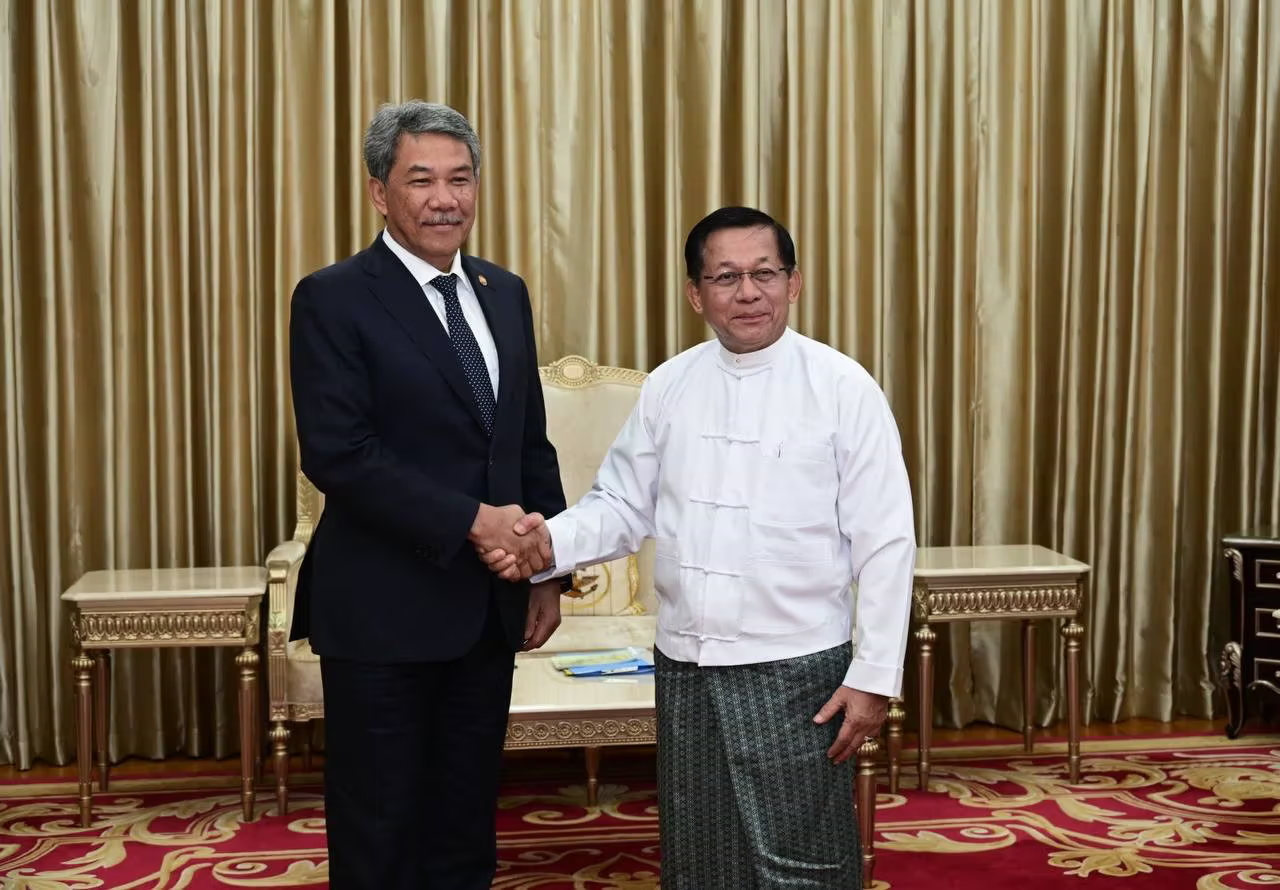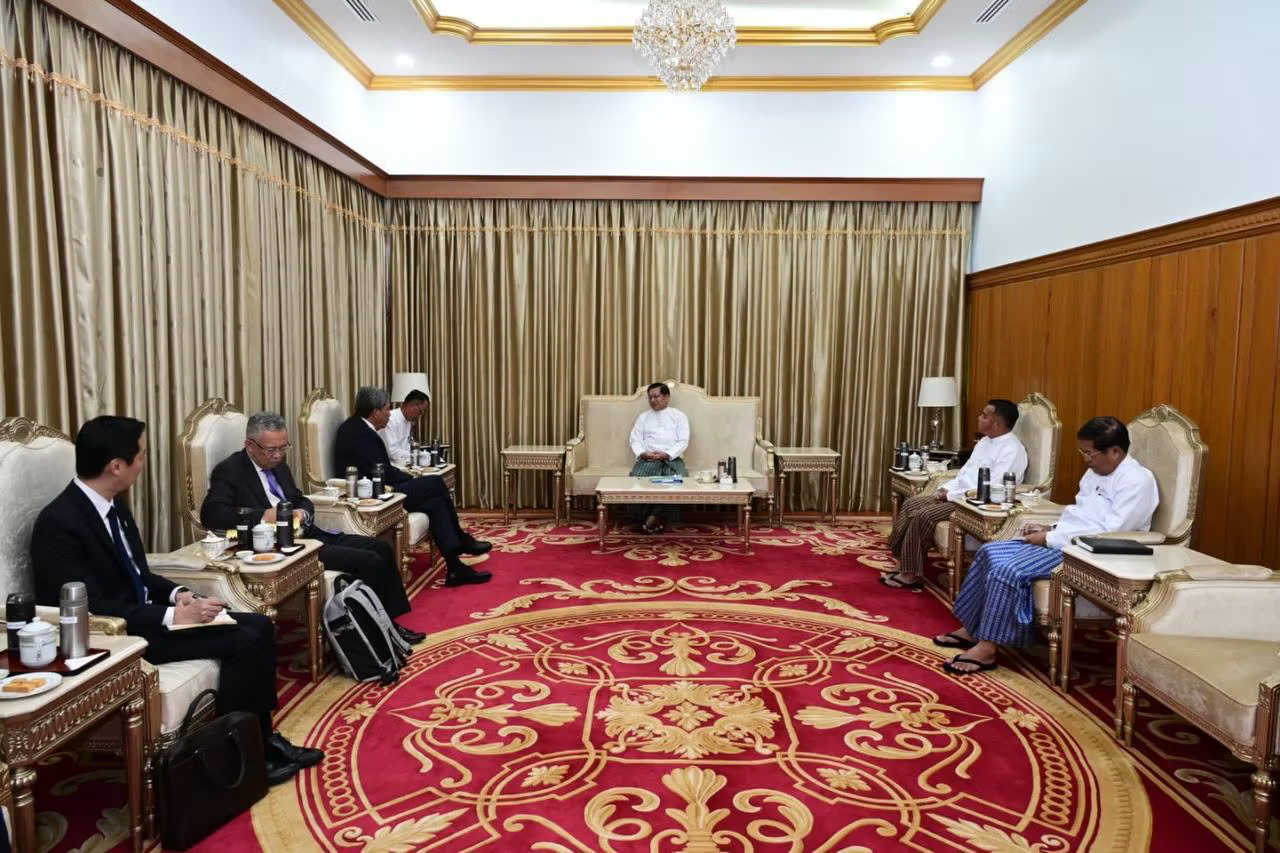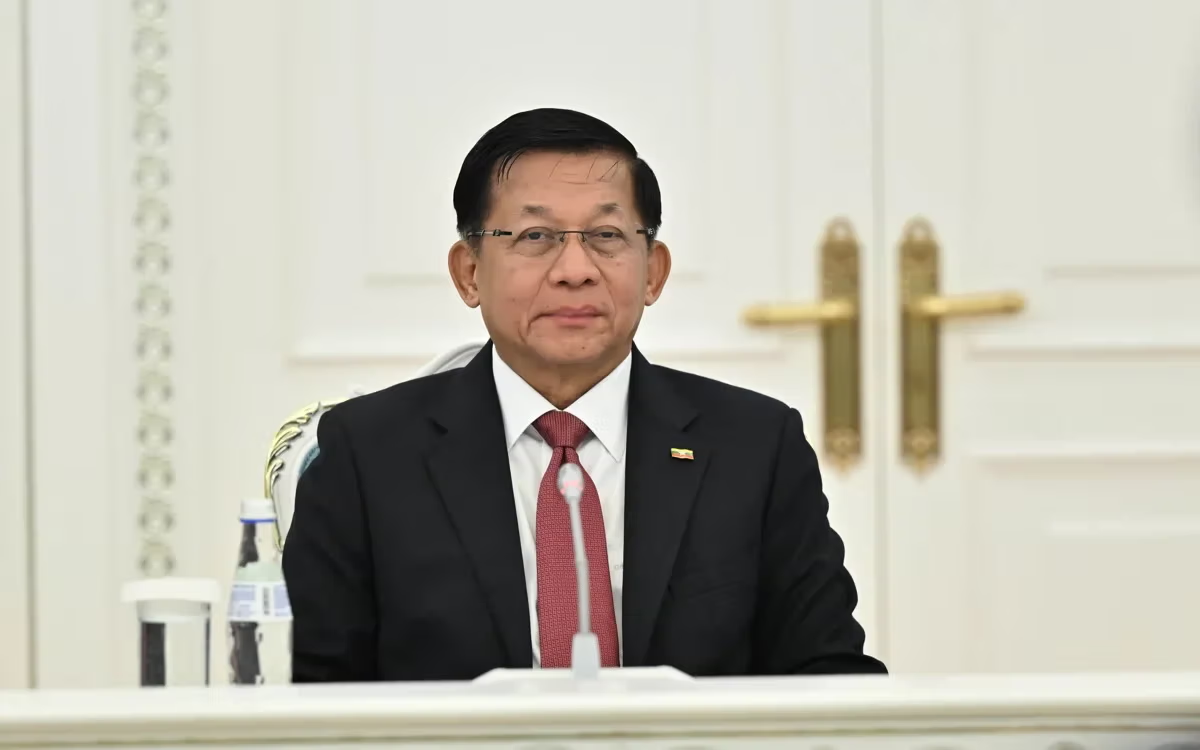
NAY PYI TAW, October 11, 2025
Myanmar's Ministry of Energy and Thailand's PTTEP International Limited will collaborate on the new Aung Theing Kha offshore gas project , aiming to begin the first extraction of natural gas in 2028.
Union Minister for Energy U Ko Ko Lwin revealed this information during a meeting with Mr. Montri Rawanchaikul, CEO of PTTEP International Limited, and his delegation on October 10 at the ministry office in Naypyidaw.
According to a press release from the Ministry of Energy, the Union Minister stated that they are working to begin natural gas extraction by 2028. He added that the ministry is coordinating to finalize the necessary agreements as quickly as possible.
The Aung Theing Kha offshore project is a new initiative designed to supply natural gas for domestic electricity production.
Mr. Rawanchaikul also presented plans to drill new wells to increase natural gas production at the declining Yadana and Zawtika offshore projects. In response, the Union Minister urged PTTEP to strive to begin production from the new Zawtika wells in early 2026.
The Union Minister also invited PTTEP to invest in new, promising offshore projects and in the import, storage, and distribution of LNG (liquefied natural gas) from the Kanbauk area in the Tanintharyi Region to both domestic and Thai markets.
#ymg/knl

NAYPYIDAW – October 9, 2025 – Malaysia's Foreign Minister, Dato' Seri Utama Haji Mohamad Bin Haji Hasan, has announced that his country will send observer missions for Myanmar's upcoming general election. The statement was made during a meeting with Myanmar's Acting President and Chairman of the State Security and Peace Commission, Senior General Min Aung Hlaing, at the Military Guest House in Naypyidaw on the morning of October 9th.
During the meeting, the Malaysian Foreign Minister expressed his satisfaction with Myanmar's preparations for a multi-party general election. He affirmed that ASEAN would cooperate to best support Myanmar's efforts and advised that the election be inclusive, according to a statement from the Myanmar government.
Senior General Min Aung Hlaing noted that the announcement for the multi-party general election was first made in 2024 to provide ample preparation time for political dissidents and parties. He stated that the registration of political parties has been conducted in accordance with the law. He informed the minister that 57 legally registered political parties with over 5,000 candidates are expected to compete in the upcoming election.
The Senior General also discussed ongoing peace efforts, stating that ethnic armed organizations have been invited to join the political process. He highlighted that the military has issued 27 ceasefire declarations since 2018 and has extended three invitations to those involved in violent activities due to political disagreements to return to the political path.

Furthermore, he announced that a ceremony for the anniversary of the Nationwide Ceasefire Agreement (NCA) will be held on October 15th. Leaders from NCA signatory ethnic armed groups, some leaders from non-signatory groups, and international witnesses are expected to attend.
The two officials also engaged in a frank discussion on a range of topics, including the current political developments in Myanmar and plans to ensure a free and fair election through the use of Myanmar Electronic Voting Machines (MEVMs). They also discussed holding the election in phases, the invitation of observer groups from neighboring countries and the international community, and Myanmar's commitment to continue on the democratic path post-election. The talks also covered Myanmar's positive cooperation within ASEAN, collaboration on humanitarian aid, and the promotion of international cooperation.
The meeting was attended by the Secretary of the Commission and Joint Chief Executive Officer, General Ye Win Oo, and by a Commission member and Union Minister for Foreign Affairs, U Than Swe. The Malaysian delegation included the Special Envoy of the ASEAN Chair to Myanmar, Tan Sri Othman Hashim, and other officials.
#ymg/knl

By- Thu Htet Thar
Across South Asia—from Nepal to Pakistan, Bangladesh, Sri Lanka, and Indonesia—a new rhythm of political mobilization has emerged. Local grievances are rapidly transforming into mass movements, and scholars are now describing this speed as digital contagion. While these uprisings are rooted in deep-seated economic hardship and widening inequality, it is the fundamental design of algorithms that is turning isolated anger into regional conflagrations.
How Algorithms Ignite the Fire
The crucial question is how these digital networks act as accelerants, transforming sparks of anger into widespread infernos. The process relies on three interlocking dynamics that accelerate mobilization:
Complex Contagion: Traditional protest required slow organization, but algorithms facilitate complex contagion. Individuals often require multiple exposures from different contacts before they decide to act. In South Asia, successive WhatsApp forwards about trials or repeated posts ridiculing corruption chipped away at hesitation until the collective momentum became irresistible.
Algorithmic Amplification: This is where the core engine of unrest lies. Algorithms are designed by platforms to reward posts that generate engagement. Research indicates that anger-laden content is six times more likely to be shared than neutral material. Videos of police brutality or the lavish lifestyles of political elites spread quickly, while neutral reports struggle for visibility. This highly engaging, anger-driven content dominates feeds, and algorithms compress it into short windows, creating an urgent fear of missing out.
Network Bridges: Algorithms enable narratives to cross borders through bridge ties. Diaspora communities (such as Pakistani communities in Europe) or student unions and YouTube influencers act as connectors, ensuring that strategies and narratives leap from one national context to another, producing regional resonance.
Who Controls the Code and Why? (Profit vs. Power)
This regional crisis forces us to confront the question of control and motivation. The algorithms reshaping fragile democracies are designed by platforms headquartered in Silicon Valley and other global tech hubs.
The primary motivation behind their design is clear: these algorithms are built to maximize engagement, not to manage political fallout. This is fundamentally an economic incentive—the corporate drive to keep users on platforms for longer. However, the unintended consequence of this profit-driven design is profound political instability.
While governments have attempted to exercise control (e.g., Nepal severing access to six major platforms or Pakistan using internet shutdowns to suppress dissent), the core tools of mobilization remain coded into corporate algorithms that reward outrage.
Conclusion
It is essential to recognize that algorithms are merely the accelerant; the hidden fuel of these uprisings remains deep-seated economic vulnerability. Algorithms simply amplify this visible disparity and sense of relative deprivation, convincing people that their limited prospects are unfair compared to the privileges of the political elites.
The selfish and irresponsible choices of profit-driven tech firms have turned their platforms into instruments of social instability. By designing algorithms that prioritize engagement above all else, these companies have knowingly built outrage machines that profit from societal discord. The algorithms' reward system, which champions anger-laden and divisive content, is not an unforeseen consequence—it is the direct result of a business model that values user clicks and ad revenue over the well-being of entire nations.
In conclusion, until societies address the dual pressures of economic hardship and the reckless behavior of tech firms, the potential for the next viral uprising is only a click away. This demands new thinking on corporate responsibility and governance in the digital age, holding these companies accountable for the instability they help create.
-End-
Reference : When Algorithms Ignite Uprisings: The Science Behind South Asia’s Viral Movements by thesciencematters.org

NAYPYITAW, 5 October, 2025 — Myanmar's Ministry of Energy is planning to upgrade its gas pipeline infrastructure to handle the increased natural gas output from the Shwe offshore project, which is expected to ramp up in 2027.
Union Minister for Energy U Ko Ko Lwin made the announcement during a visit to the Myanmar Oil and Gas Enterprise's pipe-laying base in Titut, Bago Region, on October 4. The upgrade will specifically target the 14-inch Magway-Shwedaung pipeline, which will be expanded to a 20-inch pipeline to deliver gas to factories and industrial zones in the Yangon area.
The minister also directed officials to develop plans for upgrading and installing new pipelines to accommodate increased offshore production from 2027 to 2028. He openly acknowledged significant gas losses due to aging pipelines and a lack of effective metering systems.
According to the ministry, 85% of domestic natural gas is used for power generation. However, the minister noted that inefficiencies in power plant equipment also contribute to substantial energy loss. He stated that if these losses were eliminated, Myanmar could boost its electricity output by over 30%.
In addition to the Magway-Shwedaung upgrade, the ministry will also improve the 20-inch Kanpauk-Myainggalay-Yangon pipeline, which currently transports gas from the Zawtika offshore project. The ministry's statement also mentioned that work has begun to replace and upgrade pipelines in the Yangon Region and that a new metering system will be implemented to distribute gas to individual factories from control and distribution stations.
#ymg/knl

A political tide that once seemed uniquely American is now unmistakably washing ashore in Japan. In the policies and pronouncements of Sanae Takaichi, a leading and powerful voice in the ruling Liberal Democratic Party, we are witnessing the rise of a distinctly Japanese iteration of a familiar global phenomenon: the nationalist populism championed by Donald Trump. While the cultural contexts are worlds apart, the core tenets of her platform—a fiercely protectionist "Japan First" agenda, a hardline stance on immigration, and a nostalgic appeal to national pride—echo the "America First" doctrine that has reshaped American politics.
For decades, Japan built its postwar identity on quiet multilateralism and economic interdependence. That consensus is now being challenged from within. Takaichi's political ascent signals a pivot toward a more transactional and assertive foreign policy. Her skepticism of international agreements that don't offer a clear, immediate advantage to Japan and her calls to renegotiate past trade deals mirror the transactional diplomacy that defined the Trump administration. This approach, which prioritizes short-term national gain over long-standing alliances and global norms, suggests a Japan less willing to play its traditional role as a cornerstone of the liberal international order and more inclined to go it alone.
This "Japan First" mentality extends most starkly to the issue of immigration. In a nation grappling with a demographic crisis of a rapidly aging and shrinking population, Takaichi has chosen not to embrace immigration as a solution but to frame it as a threat. Her platform is built on calls for significantly tighter border controls and restrictions on foreigners. By casting immigrants as a risk to Japan’s social fabric and cultural homogeneity, she employs the same divisive rhetoric that fueled anti-immigrant sentiment across the United States and Europe. This position overlooks the economic necessity of foreign labor for Japan and instead plays on nationalist anxieties, a classic move from the populist playbook.
Furthermore, Takaichi’s brand of nationalism is deeply rooted in a particular vision of Japanese identity and history. A staunch conservative, her regular visits to the controversial Yasukuni Shrine and her alignment with revisionist views on Japan’s wartime past are not just personal convictions; they are political statements.
To be clear, Sanae Takaichi is not a carbon copy of Donald Trump. Her politics are a product of Japan's unique history and its own conservative traditions. Yet, to ignore the striking parallels would be to miss the larger global trend. The formula of economic protectionism, stringent immigration policies, and fervent nationalism has proven potent worldwide.
As the world navigates a landscape where "America First" is once again the stated policy of the White House, the emergence of a "Japan First" advocate like Takaichi is a sign of the times. It represents a profound shift, one that could see Japan turn inward, fundamentally altering its relationships with its allies and its position on the global stage. The sun is rising on a new, more assertive, and more nationalist Japan, and its silhouette looks remarkably familiar.
-end-

Nay Pyi Taw, October 2, 2025
Myanmar Oil and Gas Enterprise (MOGE) and a Russian state-owned oil company are reportedly collaborating on the exploration and production of oil and natural gas in an onshore block located in Padaung Township.
Union Minister for Energy U Ko Ko Lwin inspected the location of Test Well No. 1 in the onshore block on October 2, according to a press release from the Ministry of Energy.
During a meeting with officials, the Union Minister emphasized the need to accelerate oil and gas exploration and production activities. He also mentioned that plans are being formulated to enhance cooperation with both domestic and international companies.
The Union Minister and his delegation also met with officials at the meeting hall of the Pyay Oil Field, which is under the supervision of MOGE. Discussions focused on the situation and future plans to increase oil and gas output from the Pyay Oil Field.
The General Manager of the Pyay Oil Field presented data regarding the field, the current status of oil and gas production through exploration and development wells, and the work plans of HNA Myanmar Oil & Gas Ltd., the joint venture partner.
The Union Minister stated that while the Pyay Oil Field is a mature field, it holds significant potential to boost the production of oil and natural gas required by the state.
He further noted that the Pyay Oil Field is capable of producing both oil and natural gas and that measures are being implemented to provide modern technology and equipment to facilitate production.
#ymg/knl

Senior General Min Aung Hlaing, how do you see the future of political and economic cooperation between Myanmar and Kazakhstan? And how do you assess the prospects for broader engagement in Central Asia?
Diplomatic relations between Myanmar and Kazakhstan began on September 23, 1999. They are now 26 years old. Our countries are gradually developing political and economic cooperation. I have met with the President of Kazakhstan twice. Central Asia and Eurasia are considered a strategically important territory—the 'Heart Land' in geopolitics—because they are located at the center of the largest continent. Therefore, the region has strategic significance. I am confident that strengthening bilateral ties will help us cooperate more actively in Central Asia as well.
Central Asia is becoming an increasingly important hub for global security and logistics. In your opinion, how could Myanmar and Kazakhstan jointly contribute to regional stability and development?
Central Asia has always been an important transport hub between Europe, the Middle East, Southeast Asia, and East Asia. The Great Silk Road once passed through here. Therefore, the region's security and development are of great importance. Kazakhstan plays an important role in Central Asia. Myanmar also has a strategic location—between China and India, connecting South and Southeast Asia as a 'land bridge.' By leveraging such advantages, our countries can cooperate, exchange products, natural resources, and culture to strengthen the stability and development of the region.
Both Myanmar and Kazakhstan actively position themselves as countries open to dialogue and multilateral cooperation. What role, in your opinion, can our states play in reforming international institutions and promoting the principles of an equitable world order?
Today, the world is shifting from a unipolar system to a multipolar one. We must reduce our dependence on one superpower and develop ties with friendly countries. This will allow for fairer decision-making and resistance to external pressure. Major changes are also occurring in the economy—a 'new world order' is forming. Smaller countries must cooperate and expand trade across different regions. International organizations need to be reformed so that they adhere to their own charters and respect the sovereignty of all countries. Our countries can cooperate in this area.
Kazakhstan is viewed as a key transit and energy hub of Eurasia. Which areas of trade, economic, and investment cooperation do you consider most promising for Myanmar in its relations with Kazakhstan and the region as a whole?
Kazakhstan is rich in natural resources, exports oil and gas, and develops mining, transport, and agriculture, especially wheat. Myanmar is an agrarian country and also has mineral resources. It borders China and India, and connects Southeast and South Asia. We have fertile land, water, and a climate favorable for agriculture. Myanmar is one of the largest exporters of rice and pulses. Therefore, the promising areas for cooperation are agriculture, mining, transport, and energy. For this, we need joint work in the field of technology and investment.
Beyond economics and politics, how important do you consider the development of cultural, educational, and humanitarian contacts between Myanmar and the countries of Central Asia for strengthening mutual understanding and trust?
"The development of educational, cultural, and humanitarian ties between Myanmar and the countries of Central Asia is a very important aspect. Our two countries have different climates, locations, cultures, and economies. The combination of these differences is an advantage. Therefore, to maintain and strengthen friendly relations between our countries, it is necessary to expand not only intergovernmental ties but also people-to-people relations, which is why the development of these aspects is extremely important."
It is recalled that Kassym-Jomart Tokayev previously held talks with the Acting President of Myanmar, Senior General Min Aung Hlaing. Welcoming Senior General Min Aung Hlaing, Kassym-Jomart Tokayev emphasized that he views his working visit to Astana as an opportunity to establish cooperation between the countries.
Translation : from Russian to English